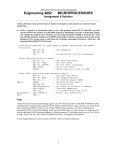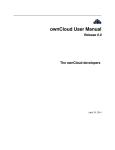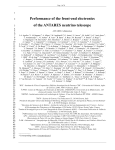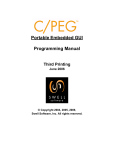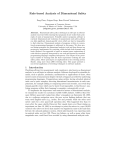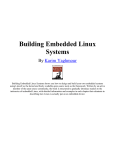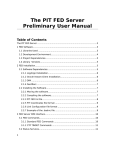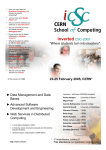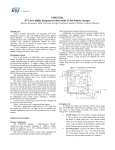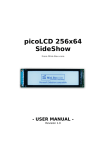Download information
Transcript
Advanced Software Development Engineering
Paolo Adragna
Università degli Studi di Siena
Debugging Techniques
1
Advanced Software Development Engineering
Why Debugging?
Debugging is a fundamental part
of programmers' everyday activity....
... but some people consider it an annoying option...
2
Advanced Software Development Engineering
USS Yorktown (1998)
A crew member of the guidedmissile cruiser USS Yorktown mistakenly entered a zero for a data value, which resulted in a division by zero. The error cascaded and eventually shut down the ship's propulsion system. The ship was dead in the water for several hours because a program didn't check for valid input. (reported in Scientific American, November 1998)
3
Advanced Software Development Engineering
Mars Climate Orbiter (1999)
The process did not specify the system of measurement The 125 million dollar Mars Climate Orbiter is assumed lost by officials at to be used on the project. As NASA. The failure responsible for loss a result, one of the of the orbiter is attributed to a failure of development teams used Imperial measurement NASA’s system engineer process.
while the other used the metric system. When parameters from one module were passed to another during orbit navigation correction, no conversion was performed, resulting in the loss of the craft. http://mars.jpl.nasa.gov/msp98/orbiter/
4
Advanced Software Development Engineering
Lecture Programme
●
Part I General Aspects of Debugging
●
Part II General Debugging
●
Part III C/C++ Related Problems and Solvers
5
Advanced Software Development Engineering
Part I
General Aspects of Debugging
6
Advanced Software Development Engineering
Part One General Aspects of Debugging
The debugging process involves:
●
Localising a bug
●
Classifying a bug
●
Understanding a bug
●
Repairing a bug
7
Advanced Software Development Engineering
Localising a Bug
#include <iostream>
// A scoping example
void c ( void ); // function prototype
int x = 1; // global variable
int main()
{
int x = 5; // local to main
// Some other code
while (x < 100)
c(); // c uses global
// Some other code
return 0;
}
void c( void )
{
//Some other code
x *= 10;
//Some other code
}
“You know what your code should do
You notice it does not do that so noticing a bug is easy”, you might say...
8
Advanced Software Development Engineering
Classifying a Bug
●
Since experiences with bugs have often a common background, we may attempt a classification:
–
Syntactical Errors: errors your compiler should catch.
–
Build Errors: errors from using object files not rebuilt after a change in some source.
–
Basic Semantic Errors: using uninitialized variables, dead code, type problems.
–
Semantic Errors: using wrong variables, exchanging operator (e. g. & instead of &&)
9
Advanced Software Development Engineering
Classifying a Bug
A funny “physical” classification
Bohrbugs and Heisembugs
Bohrbugs are deterministic: a particular input will always manifest them.
Heisembugs are random: difficult to reproduce reliably 10
Advanced Software Development Engineering
Understanding a Bug
●
●
Understand a bug fully before attempting to fix it
Ask yourself some questions:
–
Have I found the source of the problem or only a symptom?
–
Have I made similar mistakes (especially wrong assumptions) elsewhere in the code?
–
Is this only a programming error or is there a more fundamental problem (e. g. incorrect algorithm)?
11
Advanced Software Development Engineering
Repairing a Bug
●
●
Repairing a bug is more than modifying code. Make sure you document your fix in the code and test it properly.
After repair, what did you learn from it?
–
How did you notice the bug? This may help you writing a test case.
–
How did you track it down? This will give you a better insight on the approach to choose in similar circumstances.
–
What type of bug did you encounter?
12
Advanced Software Development Engineering
Repairing a Bug
●
●
After repair, what did you learn from it?
–
Do you encounter this bug often? If so, what could you do to prevent it from reoccurring?
–
What you have learnt is valuable: try to communicate it with your collegues
–
Unjustified assumptions?
After repairing a bug, write a test case to make sure it does not happen again
13
Advanced Software Development Engineering
Part Two
General Debugging
14
Advanced Software Development Engineering
Part Two – General Debugging
A) Exploiting Compiler Feature
B) Reading The Right Documentation
C) The Abused cout Debugging Technique
D) Logging
E) Defensive Programming
F) ACI Debugging Technique
G) Walking Through The Code H) The Debugger
15
Advanced Software Development Engineering
Exploiting Compiler Features (General)
●
●
A good compiler can do an amount of static analysis on your code (the analysis of those aspects that can be studied without execution)
Static analysis can help in detecting a number of basic semantic problems (e. g. type mismatch, dead code) 16
Advanced Software Development Engineering
Exploiting Compiler Features (gcc)
●
For gcc there are a number of options that affect which static analysis can be performed
–
●
Wall W
Also recommended when writing new code
–
Wshadow
–
Wpointerarith
–
Wcastequal
–
Wcastalign
–
Wstrictprototype
17
Advanced Software Development Engineering
Exploiting Compiler Feature (gcc)
●
●
●
A number of optimizations are supported. Some of these trigger gcc to do extensive code flow analysis, removing dead code.
Recommended for normal use: O2
Warning: optimisation kills debugging, so you have to choose
–
Example: gcc O3 or gcc g O0
18
Advanced Software Development Engineering
Reading the Right Documentation
●
●
●
Take the time to find at your fingertips relevant documentation for:
–
your task
–
your tools –
your libraries
–
your algorithm
You do not need to know everything
You need to be aware what documentation is relevant and what is its purpose
19
Advanced Software Development Engineering
The Abused cout Technique
●
●
●
This technique is encountered too often. It consists of ad hoc insertion of lot of printing statement to track the control flow and data values during the execution of a piece of code
Disadvantages
–
It is very ad hoc
–
It clobbers the normal output
–
Slows the program down considerably
–
Often it does not help (output buffered)
20
Advanced Software Development Engineering
The Abused cout Technique
●
●
If you consider using debugging, check out the use of assertion and of a debugger, much more effective and time saving
In some circumstances cout debugging is appropriate. Some tips:
–
Produce output on standard error (unbuffered)
–
Do not use printing statements directly: define a macro around them
–
Use debugging level to manage the amount of debugging information
21
Advanced Software Development Engineering
cout Technique Example
#ifndef DEBUG_H
#define DEBUG_H
#include <stdarg.h>
#if defined(NDEBUG) && defined(__GNUC__)
/* gcc's cpp has extensions; it allows for macros with a variable number of arguments. We use this extension here to preprocess pmesg away. */
#define pmesg(level, format, args...) ((void)0)
#else
void pmesg(int level, char *format, ...);
/* print a message, if it is considered significant enough Adapted from [K&R2], p. 174 */
#endif
#endif /* DEBUG_H */
22
Advanced Software Development Engineering
Logging
●
Logging is a common aid to debugging
●
Heavily used by daemon and services
●
It is a real solution to the cout technique
●
●
●
It records information messages which monitor the status of your program
They can even form the basis of software auditing
A sensible method is to classify log messages and label them with a priority level
23
Advanced Software Development Engineering
log4cpp C++ Logging
Log4cpp has 3 main components:
➢
Categories
➢
Appenders
➢
Layouts
A layout class controls what the output message is going to look like. You may derive your own classes from Layout or use the provided SimpleLayout and BasicLayout
24
Advanced Software Development Engineering
log4cpp C++ Logging
An appender class writes the trace message, formatted by a layout object, out to some device
log4cpp comes with classes to append to standard output, a named file, or a string buffer:
➢
FileAppender
➢
OstreamAppender ➢
StringQueueAppender
Once again you may derive your own appender (e.g. to a socket, a shared memory buffer...) 25
Advanced Software Development Engineering
log4cpp C++ Logging
A category class does the actual logging. The two main parts of a category are its appenders and its priority
The priority of a category can be set to:
1 NOTSET 5 WARN
2 DEBUG
6 ERROR
3 INFO
7 CRIT
4 NOTICE
8 ALERT 9 – FATAL / EMERG
in ascending order of importance level 26
Advanced Software Development Engineering
log4cpp C++ Logging
Each message is logged to a category object
The category object has a priority level
Priority controls which messages can be logged by a particular class. The message itself also has a priority level as it wends its way to the log If the priority of the message is greater than, or equal to, the priority of the category, then logging takes place, otherwise the message is ignored
27
Advanced Software Development Engineering
Log4cpp Example
There are six initial steps to using a log4cpp log: ➢
Instantiate an appender object that will append to a log file
log4cpp::Appender* app = new log4cpp::FileAppender ("FileAppender","/logs/testlog4cpp.log");
➢
Instantiate a layout object
log4cpp::Layout* layout = new log4cpp::BasicLayout();
➢
Attach the layout object to the appender
app>setLayout(layout);
28
Advanced Software Development Engineering
Log4cpp Example
➢
Instantiate a category object by calling the static function
log4cpp::Category main_cat = log4cpp::Category::getInstance(“main_cat”);
➢
Attach the appender object to the category as an additional appender (in addition to the default standard out appender), or set Additivity to false first and install the appender as the one and only appender for that category
main_cat.setAppender(app);
➢
Set a priority for the category
main_cat.setPriority(log4cpp::Priority::INFO);
29
Advanced Software Development Engineering
Log4cpp Example
Some examples:
main_cat.info("This is some info");
main_cat.debug("This debug message will fail to write");
main_cat.alert("All hands abandon ship");
/* you can log by using a log() method with a priority */
main_cat.log(log4cpp::Priority::WARN, "This will be a logged warning");
/* this would not be logged if priority == DEBUG, because the category priority is set to INFO */
main_cat.log(priority,"Importance depends on context");
Other example in the cited paper (see Bibliography)
30
Advanced Software Development Engineering
Log4cpp – Logfile Example
A tipical logfile:
995871335 INFO main_cat : This is some info
995871335 PANIC main_cat : All hands abandon ship
995871335 WARN main_cat : This will be a logged warning
995871335 ALERT main_cat : Importance depends on context
995871335 ERROR main_cat : And this will be an error
995871335 INFO main_cat : info
995871335 NOTICE main_cat : notice
995871335 WARN main_cat : warn
31
Advanced Software Development Engineering
Defensive Programming and the assert Macro
●
●
●
●
Take a look at your code: in every part you make a lot of assumptions about other parts
Assertions are expressions you should evaluate to be true at a specific point in your code
If an assertion fails, you have found a problem
(possibly in the assertion, more likely in the code)
It make no sense to execute after an assertion fails
32
Advanced Software Development Engineering
Defensive Programming and the assert Macro
●
●
●
●
Writing assertions makes your assumptions explicit
In C/C++ you can #include <assert.h> and write the expression you want to assert as macro argument
With assert macros your program will be aborted when an assertion fails
An assertion failure is reported by a message
33
Advanced Software Development Engineering
ACI Debugging Technique
ACI, only a joke...
●
The technique name derive from Automobile Club d'Italia, an Italian organisation that helps with car troubles...
34
Advanced Software Development Engineering
ACI Debugging Technique
ACI, not only a joke...
●
Based on a simple principle: the best way to learn thing is to teach them
In ACI debugging you find a bystander and explain to her how your code works
This forces you to rethink your assumption and explain what is really happening
It can be a form of peer review
35
Advanced Software Development Engineering
Walking through the Code
This technique is similar to the ACI technique.
The recipe:
●
Print your code
●
Leave your terminal
●
Go to cafeteria
●
●
Take the beverage of your choice, if possible with caffeine and sugar
Read your code and annotate it carefully
36
Advanced Software Development Engineering
The Debugger
●
●
●
When every other checking tool fails detecting the problem, then it is debugger's turn.
A debugger allows to work through the code linebyline to find out where and why it is going wrong.
You can interactively control the program run, stop it at various times, inspect variables, change code flow whilst running.
37
Advanced Software Development Engineering
The Debugger
●
●
●
In order to make use of a debugger, a program must be compiled with debugging information inserted (debugging symbols)
Debugging symbols describe where the function and variables are stored in memory
An executables with debugging symbols can run as a normal program, even if slightly slower
38
Advanced Software Development Engineering
Breakpoints
●
●
Breakpoints stop a program when needed –
The program runs normally until it is about to execute the piece of code at the same address of the breakpoint
–
at that point, the program drops back into the debugger and we can look at variables, or continue stepping through the code.
Breakpoints are fundamental in interactive debugging
39
Advanced Software Development Engineering
Breakpoints
●
Breakpoints have many options. They can be set up:
–
on a specific line number
–
at the beginning of a function
–
at a specific address
–
conditionally
40
Advanced Software Development Engineering
Debugging Commands
After stopping (e.g. at a breakpoint) every debugger can:
●
●
●
execute next program line stepping over any function calls in the line
execute next program line stepping into any function calls in the line
continuing running your program 41
Advanced Software Development Engineering
Watchpoints
●
●
●
Watchpoints are a particular type of breakpoints
A watchpoint stops the code whenever a variable changes, even if the line doesn't reference the variable explicitly by name
A watchpoint looks at the memory address of the variable and alerts you when something is written to it
42
Advanced Software Development Engineering
Binary Split
●
●
In large programs, adding breakpoints for every iteration of the loop is prohibitive
It is not necessary to step through each one in turn, but employ a technique known as binary split:
–
We place a breakpoint after the first of the code and run it. –
If the problem has not showed up, then it is likely to be a fault with the last half.
43
Advanced Software Development Engineering
Binary Split
–
From here, we can ask the question again, reducing the area under test to the first or the second quarter
–
This question can be asked repeatedly until we're down to just one line, or sufficiently small routine that we can step through linebyline
A binary split can limit the search area of a 1000 line program to just 10 steps!
44
Advanced Software Development Engineering
DDD – GUI for gdb
Data Display
Debugger
Powerful interface to gdb with extra features
Try it on our first example
45
Advanced Software Development Engineering
Part III
C/C++ Related Problems and Solvers
46
Advanced Software Development Engineering
Part Three – C/C++ Related Problems and Solvers
A) Preprocessor
B) Dynamic Storage Allocation
C) System Call Examination
47
Advanced Software Development Engineering
C/C++ Build Process
A brief review of steps involved in building and running a program
➢
➢
➢
Preprocessing – header files, inclusion and macro processing; output in pure C/C++ code
Compiling – translation of pure C/C++ code to assembly language
Assembling – translation of assembly code into binary object code
48
Advanced Software Development Engineering
C/C++ Build Process
➢
➢
Linking – linker combines a number of object files and libraries to produce executables or libraries
Dynamic Loading libraries (or library parts) required by a dynamically linked executables are loaded prior to actual running the executables
49
Advanced Software Development Engineering
Preprocessor
●
●
The C/C++ preprocessor:
–
expands macros
–
declares dependencies
–
drives conditional compilation
Preprocessor operations are performed at textual level. This can make tracking down missing declaration difficult or lead to semantic problem
50
Advanced Software Development Engineering
Preprocessor
●
●
If you suspect a preprocessing problem, let the preproccessor expand the file for examination
Example: gcc E –
Stops after the preprocessing stage without running the compiler. The output is preprocessed source code, which is sent to the standard output
51
Advanced Software Development Engineering
Dynamic Storage Allocation
●
●
●
In C/C++ you have to explicitly allocate and deallocate dynamic storage (through malloc/free or new/delete).
If memory is (de)allocated incorrectly, it can cause problems at run time (e. g. memory corruption, memory leak)
Common errors are: trying to use memory that has not been allocated yet; to access memory already deallocated; deallocating memory twice
52
Advanced Software Development Engineering
Memory Allocation Debugging Tools
When you have a memory problem, the best it can happen is a program crash!!!
Basically two categories of tools:
●
●
External libraries to be included and/or linked –
MEMWATCH
–
Electric Fence
Executables which controls program's run
–
YAMD
–
Valgrind
53
Advanced Software Development Engineering
Electric Fence
●
●
●
●
Electric Fence is C library for malloc debugging
It exploits the virtual memory hardware of the system to check if and when a program exceeds the borders of a malloc buffer.
At the borders of such buffer, a red zone is added. When the program enters this zone, it is terminated immediately.
The library can also detect when the program tries to access memory already released.
54
Advanced Software Development Engineering
Electric Fence
●
●
●
Because Electric Fence uses the Virtual Memory hardware to detect errors, the program will be stopped at the first instruction that causes a certain buffer to be exceeded.
Therefore it becomes trivial to identify the instruction that caused the error with a debugger
When memory errors are fixed, it is better to recompile the program without the library.
55
Advanced Software Development Engineering
Example – Memory Error
An array of 60 elements is created. The program tries to fill it with 100 elements
int main(int argc, char *argv[])
{
double *histo; histo = (double *)malloc(sizeof(double) *60));
for (int i = 0; i < 100; i++)
histo[i] = i * i;
return 1;
}
Compile the program with:
gcc g lefence Wall o memerror memerror.cpp
56
Advanced Software Development Engineering
Valgrind
●
●
Valgrind checks every reading and writing operation on memory, intercepting all calls to malloc/free new/delete
Valgrind can detect problems like:
–
usage of uninitialised memory
–
reading from / writing to freed memory –
reading from / writing beyond the borders of allocated blocks 57
Advanced Software Development Engineering
Valgrind
●
●
●
Valgrind tracks every byte of the memory with nine status bits: one for the accessibility and the other eight for the content, if valid. As a consequence, Valgrind can detect uninitialised and does not report false errors on bitfield operations.
Valgrind can debug almost all dynamically linked ELF x86 executables without any need for modification or recompilation.
58
Advanced Software Development Engineering
Example – Memory Error
An array of 60 elements is created. The program tries to fill it with 100 elements
int main(int argc, char *argv[])
{
double *histo = new double[60];
for (int i = 0; i < 100; i++)
histo[i] = i * i;
return 1;
}
Compile the program with:
g++ g Wall o memerror memerror.cpp
59
Advanced Software Development Engineering
Example – Memory Error
valgrind gdbattach=yes errorlimit=no ./memerror
.....
==3252== Invalid write of size 8
==3252== at 0x80483DA: main (memerror.cpp:9)
==3252== by 0x4026F9B1: __libc_start_main (in /lib/libc.so.6)
==3252== by 0x80482F0: ??? (start.S:102)
==3252== Address 0x410B2204 is 0 bytes after a block of size 480 alloc'd
==3252== at 0x4002ACB4: malloc (in /usr/lib/valgrind/vgskin_memcheck.so)
==3252== by 0x80483A8: main (memerror.cpp:7)
==3252== by 0x4026F9B1: __libc_start_main (in /lib/libc.so.6)
==3252== by 0x80482F0: ??? (start.S:102)
==3252==
==3252== Attach to GDB ? [Return/N/n/Y/y/C/c]
60
Advanced Software Development Engineering
Example – Forgetting the Initialisation
Consider the following simple program
#include<iostream>
int main(int argc, char *argv[])
{
double k, l;
double interval = atof(argv[1]);
if ( interval == 0.1) { k = 3.14; }
if ( interval == 0.2) { k = 2.71; }
l = 5.0 * exp(k);
std::cout << "l = " << l << "\n";
return 1;
}
●
Compile with:
g++ lm g o val3 initia1.cpp
The error doesn't cause a crash
●
The user has to give an argument as an input.
●
If the input value is not equal to 0.1 or 0.2, the value is not initialized ●
We may get unexpected results
●
61
Advanced Software Development Engineering
Example – Forgetting the Initialisation
valgrind gdbattach=yes errorlimit=no leakcheck=yes memerror
==3252== Invalid write of size 8
==3252== at 0x80483DA: main (memerror.cpp:9)
==3252== by 0x4026F9B1: __libc_start_main (in /lib/libc.so.6)
==3252== by 0x80482F0: ??? (start.S:102)
==3252== Address 0x410B2204 is 0 bytes after a block of size 480 alloc'd
==3252== at 0x4002ACB4: malloc (in /usr/lib/valgrind/vgskin_memcheck.so)
==3252== by 0x80483A8: main (memerror.cpp:7)
==3252== by 0x4026F9B1: __libc_start_main (in /lib/libc.so.6)
==3252== by 0x80482F0: ??? (start.S:102)
==3252== Attach to GDB ? [Return/N/n/Y/y/C/c]
62
Advanced Software Development Engineering
Example – Tracking Memory Leak
Typical Error
#include <string>
using namespace std;
string &xform_string_copy(const string &input);
Returning a Reference to a Dynamically Allocated Object
int main(int argc, char* argv[])
{
std::string original("I am an automatic variable");
string& stringref = xform_string_copy(original);
}
string& xform_string_copy(const string &input) {
string *xformed_p = new string("I will probably be leaked!");
//... maybe do some processing here ...
return *xformed_p; //Callers will almost never free this object.
}
63
Advanced Software Development Engineering
System Call Examination
●
●
●
●
A System Call Tracer allows you to examine problems at the boundary between your code and operating system
The tracer shows what system calls a process makes (with parameters and return value)
A tracer cannot tell you where a system call was made in your code
The exact place has to be reconstructed
64
Advanced Software Development Engineering
strace, the Linux System Tracer
●
●
●
strace is a powerful tool which shows all the system calls issued by a userspace program
strace displays the arguments to the calls and returns values in symbolic form
strace receives information from the kernel and does not require the kernel to be built in any special way
65
Advanced Software Development Engineering
strace example
#include <iostream> // for I/O
#include <string> // for strings
#include <fstream> // for file I/O
#include <cstdlib> // for exit()
using namespace std;
int main (int argc, char* argv[])
{
string filename;
string basename; string extname;
string tmpname; const string suffix("tmp");
66
Advanced Software Development Engineering
strace example
/* for each commandline argument (which is an ordinary Cstring)*/
for (int i=1; i<argc; ++i) {
filename = argv[i]; // process argument as file name
string::size_type idx = filename.find('.'); // search period in name
if (idx == string::npos) {
// file name does not contain any period
tmpname = filename; // HERE IS THE ERROR
//tmpname = filename + '.' + suffix;
}
else tmpname = filename;
// print file name and temporary name
// cout << filename << " => " << tmpname << endl; // USEFUL
}
67
Advanced Software Development Engineering
strace example
ifstream file(tmpname.c_str());
if (!file)
{
cerr << "Can't open input file \"" << filename << ".tmp\"\n";
exit(EXIT_FAILURE);
}
char c;
while (file.get(c)) cout.put(c);
}
Create a simple text file and run the program.
● The program won't find the input file...
●
68
Advanced Software Development Engineering
strace example
... but there it is!
69
Advanced Software Development Engineering
strace example
Let's start strace: strace o strace.out stracex list
brk(0x804a76c) = 0x804a76c
brk(0x804b000) = 0x804b000
open("list", O_RDONLY) = 1 ENOENT (No such file or directory)
write(2, "C", 1) = 1
write(2, "a", 1) = 1
write(2, "n", 1) = 1
write(2, "\'", 1) = 1
write(2, "t", 1) = 1
write(2, " ", 1) = 1
write(2, "o", 1) = 1
write(2, "p", 1) = 1
write(2, "e", 1) = 1
write(2, "n", 1) = 1
70
Advanced Software Development Engineering
Acknowledgments
I would like to thank very much J.H.M. Dassen and I.G. SprinkhuizenKuyper for letting me use some of their material on debugging techniques
A big thank also to P. F. Zema, my collegue in ATLAS, for useful technical comments and ideas exchange on Linux debugging.
Thanks to E. Castorina for a critical review of the lecture slides
71
Advanced Software Development Engineering
Bibliography
●
●
●
●
●
For more famous bugs, take a look to Prof. G Santor's site: http://infotech.fanshawec.on.ca/gsantor/Computing/FamousBu
gs.htm
J.H.M. Dassen, I.G. SprinkhuizenKuyper, Debugging C and C++ code in a Unix environment, Universiteit Leiden, Leiden, 1999
T. Parr, Learn the essential of debugging, IBM developerWorks journal, Dec 2004
S. Best, Mastering Linux debugging techniques, IBM developerWorks journal, Aug 2002
S. Goodwin, The Pleasure Principle, Linux Magazine 31(2003) 64 69
72
Advanced Software Development Engineering
Bibliography
●
gdb User Manual
●
gcc User Manual
●
Valgrind User Manual
●
F. Rooms, Some advanced techniques in C under Linux
●
●
●
●
W. Mauerer, Visual Debugging with ddd, The Linux Gazette, Jan 2001
M. Budlong, Logging and Tracing in C++ Simplified, Sun Developers Technical Articles, 2001 S. Goodwin, D. Wilson, Walking Upright, Linux Magazine 27
(2003) 76 80
J. World, Using Log4c, online at http://jefficus.usask.ca
73
Advanced Software Development Engineering
Backup Slides
74
Advanced Software Development Engineering
Localising a Bug
●
●
●
“You know what your code should do, you notice it does not do that so noticing a bug is easy”, you might say...
Noticing a bug implies testing, so this easiness is completely deceptive
In case of a test failure you have to see what went wrong, so prepare your tests carefully
75
Advanced Software Development Engineering
Introduction
●
●
●
When your program contains a bug, it is likely that, somewhere in the code, a condition you believe to be true is actually false
Finding your bug is a process of confirming what you believe is true until you find something that is false.
“My program doesn't work” is not an acceptable statement
76
Advanced Software Development Engineering
Introduction
●
●
The importance of the way how to find errors and fix them in the life cycle of a software product is a task whose importance cannot be stressed enough over and over
Finding errors is not just an unavoidable part in the development cycle but vital part of every software system's lifespan.
77
















































































